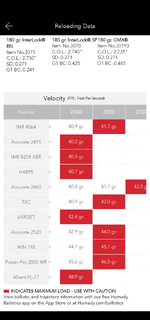Alright, I’m back with more noob questions:
Planning on loading up some 178 ELD-M over Accurate 2520 for my Tikka 308. It’s what I have on hand.
I can’t find load data from a supplier for this combo. However, Hodgdon has plenty of 2520 loads behind 175s and 180s. I figured I’d split the middle (since grain weight is in the middle) but I don’t understand how to. They have 6 180gr bullets and 2 175gr bullets with 2520. The 180s have the highest and lowest starting charge (between the 8 different bullets) and they also have the highest and lowest max charge (between the 8 different bullets). Basically, it seems you should start anywhere from 39-41gr and max out anywhere from 43-45.5gr.
Now here’s my issue, I drive 50 minutes to the range. I want to load up 3 rounds each at varying charge weights that aren’t too low (to not waste components on a load I won’t use) and not too high (so I don’t load a dozen rounds I’ll have to pull apart cause I hit pressure very early).
How do you interpret data for a bullet that’s not listed anywhere? Thanks!
Planning on loading up some 178 ELD-M over Accurate 2520 for my Tikka 308. It’s what I have on hand.
I can’t find load data from a supplier for this combo. However, Hodgdon has plenty of 2520 loads behind 175s and 180s. I figured I’d split the middle (since grain weight is in the middle) but I don’t understand how to. They have 6 180gr bullets and 2 175gr bullets with 2520. The 180s have the highest and lowest starting charge (between the 8 different bullets) and they also have the highest and lowest max charge (between the 8 different bullets). Basically, it seems you should start anywhere from 39-41gr and max out anywhere from 43-45.5gr.
Now here’s my issue, I drive 50 minutes to the range. I want to load up 3 rounds each at varying charge weights that aren’t too low (to not waste components on a load I won’t use) and not too high (so I don’t load a dozen rounds I’ll have to pull apart cause I hit pressure very early).
How do you interpret data for a bullet that’s not listed anywhere? Thanks!
Last edited:


